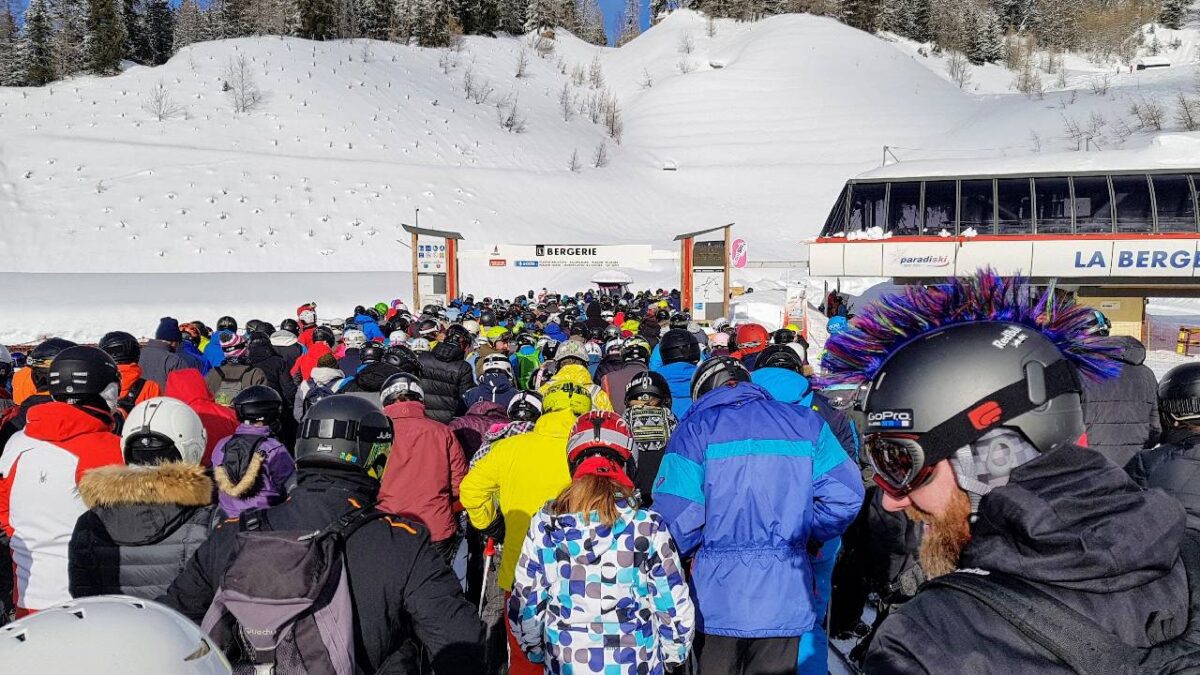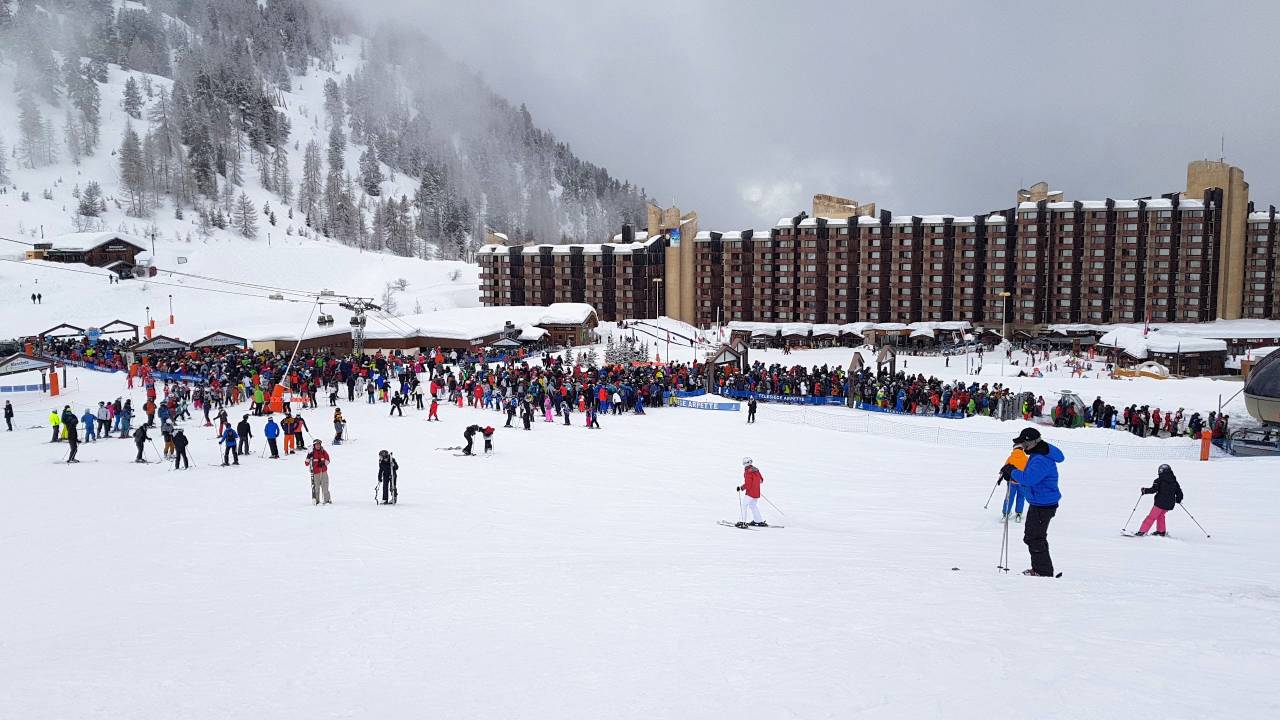La Plagne lifts to avoid

All ski areas the world over have certain lifts that are best avoided unless absolutely necessary and La Plagne is no exception. More often than not, these lifts are the main arterial routes out of the resort – which applies equally in La Plagne. However, here, it’s also exacerbated further by these lifts also being popular with ski schools. Below is our guide to La Plagne lifts to avoid.
The problem with arterial links
While more or less all the uplift can suffer from queues through the busier holiday periods, there are two that, year on year, come out on top: the Arpette out of Plagne Bellecôte and the Bergerie that runs between Plagne Soleil and Plagne Villages. In both cases, you’d be well-advised to avoid these lifts – particularly after 10am when the ski schools get going and also after 3pm (although, in truth, both are busy most of the day regardless). Another link lift that frequently gets busy is the ancient Belle Plagne Roche de Mio gondola. Check our ‘When is the best time to ski in La Plagne‘ feature to learn more about the busiest periods in the resort.
NOTE – wait time is just one aspect of problematic lifts so we’ve used three different classifications – queues, speed and difficulty.
Queues: the Arpette chair (Bellecôte)
The Arpette chair rises from Plagne Bellecôte and serves the main uplift for getting out and over to the Montchavin sector and, thereafter, Les Arcs. The Arpette also happens to feed some of La Plagne’s best blue pistes (Arpette, Lainés and Dunes) as well as La Plagne’s funslope (claimed to be the longest in Europe). Consequently, this lift is busy in the mornings and afternoons with skiers making the trip from La Plagne to Les Arcs – but often stays busy with beginner riders lapping these pistes.
If you do need to take this lift, it’s best to go super early in the mornings or over the quiet lunchtime period – both of which see the queues die down considerably. Of course, this can vary depending on the time of season. However, despite being one of La Plagne’s fastest lifts, it often struggles to keep up with demand.
While plans are apparently afoot to build a new lift from the foot of the Inversens red up to the Crozats lift and Teppes blue piste which would relieve pressure here caused by skiers and snowboarders returning from Roche de Mio, it’s unlikely this will do much to persuade people to travel that far just to get over to Montchavin.
Tips to avoid the Arpette: Unfortunately there really isn’t any way to avoid taking the Arpette if you want to get into the Montchavin sector. Technically, you could get up to Roche de Mio then take the Inversens red followed by the Crozats black and Route des Bauches blue – but, really, you’d spend way more time on this route than just waiting for the Arpette in the first place.
Queues (after 3pm): the Colosses chair (Bellecôte)
It might seem a little unfair to include the 8-person Colosses chair in this list as, in the main, it deals admirably with demand and operates without issue most of the day. However, after around 3pm (and often in the early morning), queues frequently form here. Afternoons can be particularly problematic as riders make their way back from Les Arcs, Montchavin and the Bellecôte sector to other areas in La Plagne. Just a quick look at the piste map shows this lift as the easiest way to access the right of the piste map – Plagne Soleil, Plagne Villages, Plagne Centre, Aime 2000, Plagne Montalbert and even Champagny – so queues are somewhat inevitable.
That said, the Colosses was once the fastest chairlift in France and, for the majority of the time, this high-speed, detachable behemoth does a great job. A top tip can be to stop past the Le Bonnet bar / restaurant terrace and watch for queues increasing or decreasing.
Tips to avoid the Colosses: This will largely depend on where you’re staying and the time of day. For example, if you’re staying in Champagny, a much quicker option to reach home would be to take the Blanchets chair (always the quietest of the Bellecôte lifts) and drop over the other side taking the short Quillis piste onto the Levasset blue. An alternative route would be to take the Roc du Diable blue followed by the Geisha blue. If you’re staying in Centre, both these routes would allow you to take the Verdons Sud chair back to the main area. This route could also be used to get to Aime or Montchavin via the Becoin chair (followed by Adrets for Montchavin). However, you should factor in travel time to these routes to avoid getting stuck.
Queues / speed: the Roche de Mio gondola (Bellecôte)
La Plagne’s lift management company, SAP, is in the process of modernising the ageing Roche de Mio gondola with an expected go-live date of next season. Click this link to read more about the new Roche de Mio lift and its new route. Meanwhile, the lower section (the Belle Plagne gondola lift) will remain in use but will be used almost exclusively for pedestrain access between Bellecôte and Belle Plagne.
Both these lifts date from the early ’70s and crawl at a snail’s pace up the hill when compared to more modern lifts seen in other ski and snowboard areas – so the new development is very welcome (and, in truth, well overdue). The low-capacity 6-person cabins are both uncomfortably and noisy – really not befitting of a world-class ski station and most definitely not up to the task of serving the amount of traffic trying to reach the higher Roche de Mio areas. Season 2025/26 will finally see this improved.
Tips to avoid the Roche de Mio: Of all the Plagne Bellecôte hub of lifts, the one that stays most consistently quiet is the Blanchets detachable chair – yet this lift can give you much quicker access to Roche de Mio if you link at the top onto the Quillis blue then take the long Carella detachable chair to the summit. It’s a much-underused trip that will see you escape most of the crowds.

Queues: the Bergerie chair (Plagne Soleil)
Another of La Plagne’s lifts to try and avoid if you can is the Bergerie chair that travels from a little above Plagne 1800 and below Plagne Centre past Plagne Villages and Plagne Soleil to a junction that lets you ride to Plagne Bellecôte or Plagne Centre. Consequently, this lift gets busy with traffic from almost all areas with riders trying to get over into the Plagne Bellecôte / Roche de Mio sector. Indeed, when you look at the piste map, it’s clear to see the only other way over to Bellecôte is via the Funiplagne (Petite Rochette > Leitchoums or Mira > Trieuse).
Because of the vital connection the Bergerie serves, this lift can be busy at pretty much any time of day – but that situation is made all the worse when the ski classes kick in. The Écartée piste below this chair is one the most popular with ski instructors so this lift is almost always rammed with beginner skiers and snowboarders. Also, while the chair itself is fast, it frequently has to stop with novices falling at the on- and off-ramps.
Tips to avoid the Bergerie: If you’re staying in Plagne Soleil, make the short walk up to the Dou du Praz drag lift at the top end of town and take this followed by the Bretelle Trieuse blue to get to Bellecôte. This route is significantly quicker. From Villages, it’s possible to take the Aollets drag lift (see more on this lift later) followed by a short section of the Mira blue and then the Trieuse blue. Likewise, if you’re coming from anywhere right of Plagne Centre (as you look at the piste map), you would be quicker just taking the Funiplagne then linking off the Mira blue to Trieuse.
Queues: the Colorado chair (Plagne Centre)
Somewhat annoyingly, the runs below the Colorado chair have some of La Plagne’s most interesting on-piste terrain with banks, natural quarterpipes and easily accessible gullies – especially the lower half of the Puy du Fou (previously called Pollux). Nonetheless, this is another lift that is favoured by ski schools so it frequently gets busy (particularly in holiday periods). The lift itself is fast and efficient – the problems come through demand.
Tips to avoid the Colorado: The most obvious solution to avoiding this lift is to take the Funiplagne instead. While this gondola can also suffer from queues, its capacity means wait times are significantly reduced – plus it tends not to be used by ski schools catering to lower-level students. Also, many beginner riders are intimidated by the pitch of the runs off the top – the Carina red and Mira blue (the top part of Mira is very steep for an intermediate piste and is not particularly suited to beginner ski schools). Another alternative is to take the new Lovatière high-speed chair which also tends not to attract riders of less ability.
Speed: the Salla chair (Montchavin)
The Salla is one of La Plagne’s older lifts that you’d be best to avoid. This lift creeps its way up the hill at a spectacularly slow speed – a point you’ll definitely note on colder days. Moreover, the lift is more of a transit link back from Montchavin to get to the Bellecôte bowl and doesn’t really serve any pistes of note. Sure, you could ride the Replat blue but this isn’t a run you should spend any time on considering the other pistes in this area.
Tips to avoid the Salla: The easiest way to avoid the Salla is to continue down the hill a little further and take the base of the Teppes blue piste to the Crozats chair. This high-speed detachable chair whisks you to the summit far quicker – plus gives access to much better runs at the top – the Teppes blue, Marmottes red towards the Inversens chair or the short Barrières blue back towards Plagne Bellecôte, Belle Plagne and the pistes in the Bellecôte sector.
Speed: the Dos Rond chair (Montchavin)
The Dos Rond sits at the top of the Pierres Blanches chair and is often a tempting option when returning from the Montchavin side of the mountain – however, this too is an aging lift that crawls its way up the hill. Thankfully there are other, better options.
Tips to avoid the Dos Rond: If you’re riding the pistes in this area, the easiest solution is to stick to the much quicker Bijolin chair which will drop you a little lower but still gives full access to the best runs. Alternatively, if you have taken the Pierres Blanches, a much quicker option is to take the Plan Leschaux poma. This also drops you at the summit point where you can choose to ride to the Crozats chair (if returning to Bellecôte bowl) or ride the main Montchavin pistes again (including Mont Blanc). Sure, not everyone likes drag lifts – but this is by far the quickest way up the hill.
Speed: the Bauches chair (Montchavin)
The slow Bauches chair serves the Bauches blue piste as well as giving a link back from three other black runs below Roche de Mio. However, in truth, the main reason for this lift is as a way back from some of La Plagne’s tougher off-piste routes off the Bellecôte glacier and RdM.
Tips to avoid the Bauches: Put very simply, unless you have the skills to be riding these backcountry routes, you’ll have very little reason to take this lift. While it’s true the Bauches blue does have some interesting off-piste, the run itself is rather boring, snaking its way down to the base on a zigzag cat-track. It’s most certainly not a piste you’d want to spend any time riding.
Difficulty: the Crêtes poma (Aime 2000)
Technically, the Crêtes isn’t a lift to avoid as such as it gives access to some great off-piste riding – particularly if you’re willing to hike. However, this poma is marked with a warning triangle for good reason as it’s only suitable for confident intermediate riders and above. Also, when you consider the terrain it accesses, only good skiers and snowboarders should attempt it. The lift has a strong kick at the start before climbing a very steep incline followed by a dogleg to the left about 1/3 up.
Tips to avoid the Crêtes: If you don’t have the skills to ride the poma, you’ll likely have significant problems riding the on- and off-piste options it accesses. This is definitely a case of knowing your ability level and choosing appropriately.
Difficulty: the Aollets poma (Plagne Villages)
Similar to the Crêtes above, the Aollets isn’t a lift to necessarily avoid as such – rather, it can be tricky for lower-level riders. This lift also features a kick at the start followed by a steep climb out of Villages before taking a dogleg right. Presuming you’ve got past these sections without issue, you’ll then be faced with frequent downhill sections where you’ll need to brake to avoid outrunning the lift. This can prove particularly difficult for skiers and (especially) snowboarders of lower ability.
Tips to avoid the Aollets: If you’re staying in Plagne Villages (which really is the only reason you should find yourself taking this lift), the easiest option is to ride down to Centre and take one of the lifts from there.
Difficulty: the Col de Forcle poma (Bellecôte)
The Col de Forcle is another lift that requires a higher level of ability to ride and, consequently, is marked with a warning triangle. It too features a dogleg midway up that can be difficult if you don’t have the skills. Nonetheless, if you’re up to it, the CdF poma rarely suffers from queues and is particularly useful for doing laps in the snow park. It can also be a good route to quickly get out of Belle Plagne by avoiding the Bellecôte lift hub.
Tips to avoid the Col de Forcle: By far the easiest way to avoid this lift is to stick to the Blanchets chair which gives access to the same terrain – plus offers a longer route back.
Difficulty: the Tyrolien poma (Bellecôte)
The Tyrolien is a very short drag lift reached from the Belle Plagne piste that is used purely to get back to Belle Plagne Haut from the lower Belle Plagne Bas. You’ll only ever use this lift at the end of the day to get home but, due to the sharp incline, lower-skill riders would be well advised to avoid it.
Tips to avoid the Tyrolien: If you want to avoid this lift, ride to the middle lift station of the Roche de Mio gondola then walk to your accommodation. Alternatively, you could think ahead and take the Arpette lift followed by the Lainés piste, a run that goes directly through the higher parts of Belle Plagne.
La Plagne month-by-month guides
If you want to learn more about the busiest times and areas in La Plagne, check the guides below which give a month-by-month breakdown of the full conditions, queues and typical snow at different points during the season.
What is La Plagne like in December?
What is La Plagne like in January?
What is La Plagne like in February?
What is La Plagne like in March?
What is La Plagne like in April?
In terms of the difficulty of runs and pistes, we also have three articles that might help – Is La Plagne good for beginners, Is La Plagne good for intermediates and Is La Plagne good for experts.
La Plagne accommodation deals


